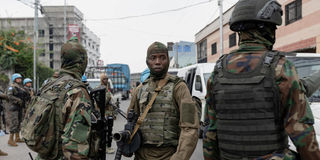Premium
States should strike delicate balance in pursuit of peace in Great Lakes region

Members of the M23 rebel group supervise the exit of mercenary troops in the streets of Goma amid conflict between them and the Armed Forces of the Democratic Republic of the Congo (FARDC), in Goma, eastern Democratic Republic of the Congo, January 29, 2025.
The current March 23 Movement (M23) offensive in the eastern Democratic Republic of the Congo (DRC) has placed several states in Africa’s Great Lakes Region on a trajectory of instability, war, and potential destruction.
Indeed, an intense flare-up of this magnitude, involving rebel groups in the eastern DRC and neighbouring states, has not been witnessed in the region for over two decades. According to the United Nations (UN), approximately 3,000 people have lost their lives, and nearly 2,880 have been injured during the current conflict, triggered by the M23 capture of the eastern DRC city of Goma on 27th January 2025. This situation poses multiple risks and endangers the civilian population in the region.
There is a need for peace initiatives and de-escalation of inter-state tensions between Burundi, the DRC, Rwanda, and Uganda, which must look beyond the current M23 offensive to the complex web of historical events that form the structural causes of the protracted conflicts.
First are the deeply rooted effects of the colonial legacy, including arbitrary state boundaries and oppressive actions by Belgian authorities, which led to the deliberate displacement of communities such as the Banyarwanda and Banyamulenge in the 1930s. This involved large-scale migration of Tutsis from both Rwanda and Burundi to the eastern DRC.
Second is the ‘Social Revolution’ (1959–1960), which preceded Rwanda’s independence and resulted in the displacement of approximately 480,000 Tutsis, with similar displacements occurring in the 1970s and 1990s. Third is the Rwandan genocide of 1994, in which over 800,000 Tutsis and moderate Hutus were killed, leading to further displacements and the formation of ethnic-based militia groups such as the contentious Forces Démocratiques de Libération du Rwanda (FDLR).
Second Congo War
Fourth are the First Congo War (1996–1997), fought between Rwanda and the then-Zaire with the involvement of other African states, and the Second Congo War (1998–2002), which saw the participation of nine African countries and approximately 25 armed groups, making it one of the largest wars in African history.
Additionally, the availability and increasing demand for precious minerals such as cobalt, lithium, gold, and lead have led to a scramble for the mineral-rich regions of the DRC, with private investors colluding with armed groups to secure and conduct illegal mining.
Cumulatively, these factors have resulted in the fragile nature of the DRC: a weak state, an unstable political environment, vast ungoverned spaces, numerous external players, European mercenaries, and the presence of other negative forces.
Furthermore, the uncontrolled extraction of the DRC’s resources by external powers, using states in the region as conduits, has exacerbated the situation, leading to conflicts, mistrust, and inter-state tensions. With the capture of Goma and South Kivu’s regional capital, Bukavu, M23 has signalled its readiness to ‘march to Kinshasa’ to oust the Tshisekedi regime, creating unease among all states in the region.
The DRC has taken a hard stance against Rwanda, labelling M23 a terrorist group. Uganda has deployed over 1,000 additional soldiers into Bunia, the capital of Ituri Province in the DRC.
Burundi already has forces in the eastern DRC, increasing the risk of clashes with M23. The escalating tensions signify serious security and humanitarian concerns for states and will also have negative repercussions on trade and the movement of goods and services in the region. Based on these dynamics, there is a clear risk of the region facing a ‘Third Congo War’ if productive, concrete, non-coercive, and diplomatic steps are not taken immediately. To this end, the robust actions of the East African Community (EAC) and the Southern African Development Community (SADC) Heads of State are pivotal.
These provide an appropriate avenue, using existing African continental structures, to resolve the conflict. The recently concluded joint EAC–SADC Summit of Heads of State and Government in Dar es Salaam, Tanzania, on 8th February 2025, made important decisions towards de-escalating tensions and paving the way for peace in the DRC.
The conflicting parties should adhere to the Summit’s decisions, as a cessation of hostilities and a ceasefire would prevent further deaths and allow the flow of humanitarian aid. The Summit’s approach ensures inclusivity, involving all actors, and aims at a peaceful resolution of the conflict using non-coercive means. It avoids victimising key actors, thereby helping to build trust and confidence between the conflicting parties for sustainable peace.
The DRC–M23 conflict offers valuable lessons for African states in addressing structural concerns such as arbitrarily drawn colonial boundaries and cross-border communities, which contribute to conflicts and undermine state-building processes on the continent. The ability to resolve this crisis serves as a critical test for Africa’s leadership and the ‘African Peace and Security Architecture’ in addressing conflicts using home-grown solutions.
Lt Gen (Rtd) Adan Mulata is the executive chairman of Prospect Peace Institute, an African peace think tank.


